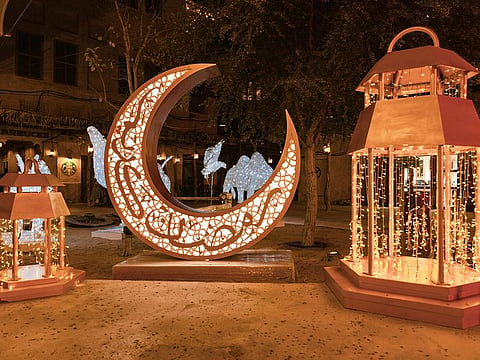Here's a Ramadan walking tour of the Bur Dubai heritage district
From Al Shindagha to Al Seef, create some new memories in the oldest part of the emirate

Once a year in Ramadan, we gather around the glass-topped tables of Special Ostadi in Bur Dubai. There are six or maybe nine of us, coming from New Dubai, Sharjah, Satwa and Abu Dhabi. As we side eye our phones for the maghrib prayer to signal fast’s end, we’ll turn our attention to the photos on the walls and inventory the defunct currencies under the glass on each table. Someone will ask if the Sultani kebabs (Dh57) are still available and have been ordered, before someone else straggles in late, blaming non-existent traffic at the one time of day in the only month of the year when the roads are nearly always empty.
Before we can roll our eyes at each other, prayers are being said, dates passed around and water gulped audibly. Owner Majeed Ali Ansari comes over and embraces each of us, stopping to chat and ask about someone he remembers from years ago. For one all-too-brief evening, we’re first-timers to Dubai again, discovering this city anew. The years fall away, urgent WhatsApp messages and social media updates forgotten. Former strangers, now family, all home again. We’ll eat everything on the menu, quibble over varied recollections of a long-ago event, linger over Irani chai and make hasty plans for more get-togethers that we will renege on soon.
But nobody cancels iftar at Special Ostadi. That’s the magic of Bur Dubai, the heritage district where you’re a dhow trip away from Iran, or India, or Oman, where you can still buy a sim card on the street, where you’ll also find exquisite hand-embroidered slippers and intricate filigree jewellery, and where you can snap up formative work by emerging artists before they become collectible. You can find everything that makes Dubai what it is here, all tinged with that Ramadan magic. Only, the freshest spices require an abra ride across the creek — at Dh2 one way, it’s one of the cheapest ways to get a lesson on Dubai’s urban history.
Bur Dubai is the emirate’s family album of historic memories. Start at the oldest building, Al Fahidi Fort. Dating back to 1787 and once home to Dubai’s ruling family, the coral and mortar structure served variously as a defence border post, a prison for outlaws, and a garrison for troops before opening as a museum in 1971, the year of the UAE’s federation. An entry fee of Dh3 offers a peek into millennia gone by; the oldest artifacts date to 3,000BC. It’s shut for renovations right now, so skip over to the Coffee House Museum instead, a stone’s throw away in the Al Fahidi Historical Neighbourhood, or to old-timers, Al Bastakiya. Home to gypsum, stone and wood buildings dating back over a century, this was where the city’s sea-traders once lived, many with roots in Bastak in present-day Iran.
Also in this cluster of former homes with their distinctive wind towers is the beginning of Dubai’s contemporary art scene. Entry is free to most venues, although appointments may be necessary because of the pandemic. The XVA Gallery has displayed emerging Middle Eastern art since 2003 (the Ramadan exhibition features the Brazilian-born Elizabeth Dorazio), while also housing a hotel and art café. At the century-old House No13, the Al Serkal Cultural Foundation hosts architectural and philatelic lectures and poetry recitals.
The historical district sits in the centre of the extended market area known variously as Souk Al Kabeer or Meena Bazaar, traditionally where the emirate’s Indian community went shopping for bridal finery and gold jewellery. The city’s oldest fabric stores and best budget-friendly vegetarian restaurants are here. Max out your credit card on a 24-carat trinket or on diamond jewellery cut in the traditional Indian polki style at Meena Jewellers. Stop for a quick snack of fafda (Dh6.50) or a Gujarati buffet (Dh21) at Bhavna’s. Closer to the creek’s edge sits a collection of traditional shops in the old souk.
Stop for a photo – or a prayer — at one of the mosques here. The Bur Dubai Grand Mosque dates to 1900 and boasts the city’s tallest free-standing minaret at 70 metres, executed in the Anatolian style. Nearby, the azure façade of the Iranian mosque on Ali Bin Abi Taleb Street is equally Instagram-worthy. A couple of kilometres westwards, you’re in the heart of the Al Shindagah heritage village. Its highlight is the Sheikh Saeed Al Maktoum House, seat of Dubai’s longest-serving ruler and where many royals were born. Nine wings at different levels document different aspects of the emirate’s Modern history, from its financial and marine life to social events. Food fanatics will gravitate automatically to the waterfront Kan Zaman.
Walk eastwards to Al Seef, the waterfront leisure promenade that serves as a contemporary foil to the heritage area. Until Eid Al Fitr, the venue is hosting a series of Ramadan Art Nights with work by popular local artists. Afterwards, browse through Al Seef’s street markets, or stop off at one of the many restaurants in the area (Egyptian Khofo and Indian restaurant Mitra are the two standouts) for an early suhour meal before framing the memory for posterity with a photo on the trendy flower swing. Perhaps you can start a new tradition of your own.
Sign up for the Daily Briefing
Get the latest news and updates straight to your inbox


